One of the most fascinating aspects of Southeast Asia travel is to experience the dazzling weave of ethnic groups, languages, religions and customs, all blended yet distinct.

Penang Island, strategically poised at the head of the Straits of Malacca, has been endowed by geography and shaped by trade for centuries. Beginning with the Malays, other peoples have lent their influence (by whatever means) into the mix: Arab traders, Hindu and Chinese immigrant laborers, the European traders and colonists — Portuguese, then Dutch — and finally – British, both before and after World War II’s Japanese occupation. Sometimes it seems that only the Roman Empire has not left its genes and culture in the region.
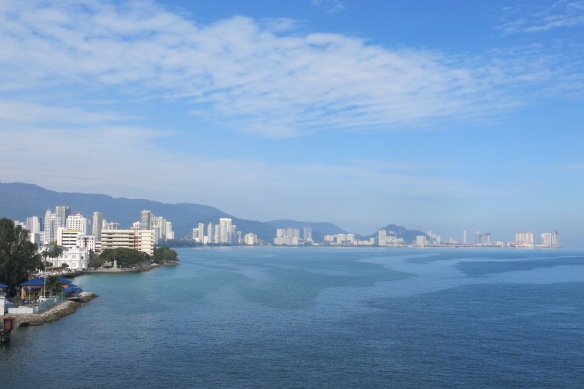
View to the east of George Town, Penang Island, Malaysia
Still a lively port city, Penang of today shows most clearly the influence of four different cultures: Chinese, Malay, Hindu and British. However, despite being a region of Malaysia, a predominantly Muslim nation, Penang clearly reflects the culture, architecture and religion of its southern Chinese majority from the mid-19th century up to today.
Since its independence from Great Britain, the Malaysian government has “re-balanced” the Penang population so that the numbers of Chinese and Malays are now fairly even at 46% and 43%, respectively. Additionally, the inevitable blend of Chinese and Malays over the centuries has resulted in a unique culture, Peranakan, both in Penang and in other “Straits” cities such as Malacca and Singapore.
The Chinese influence is still quite visible in today’s Penang, especially in Chinatown and the more urban areas of the island, by the number of merchants and shops, and, not least, the number of Buddhist temples on the island. (Buddhists comprise 36% of the population, second only to Muslims at 45%.)
Tek Lok Si
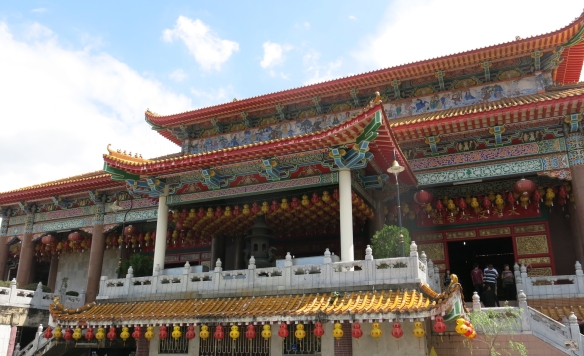
Main temple at Kek Lok Si
Tek Lok Si is not only the largest Buddhist temple complex in Penang, but the largest in Southeast Asia. Also known as the “Chinese Buddhist Temple” and “Temple of 10,000 Buddhas,” Tek Lok Si is dazzling in size and beauty. The main temple was begun in 1890, with additional edifices constructed over the years.
The cavernous main temple is dominated by three golden statues of the Buddha in meditative pose. In a ship-board lecture series on Buddhism, I learned the symbolism of a three Buddha display: the center statue is of the current Buddha, the one who most Westerners think of as the Buddha, Sidhartha; the Buddha on the left depicts the future Buddha, while the one on the right represents the Buddha of the past.
The current Buddha
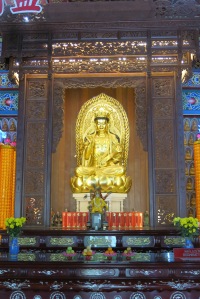
The Past Buddha

The Future Buddha.
The walls were lined with niches containing far smaller statuary of the Buddha. (We didn’t attempt to count them all!)

Kek Lok Si’s walls are rows of niches containing small, gold Buddha statues
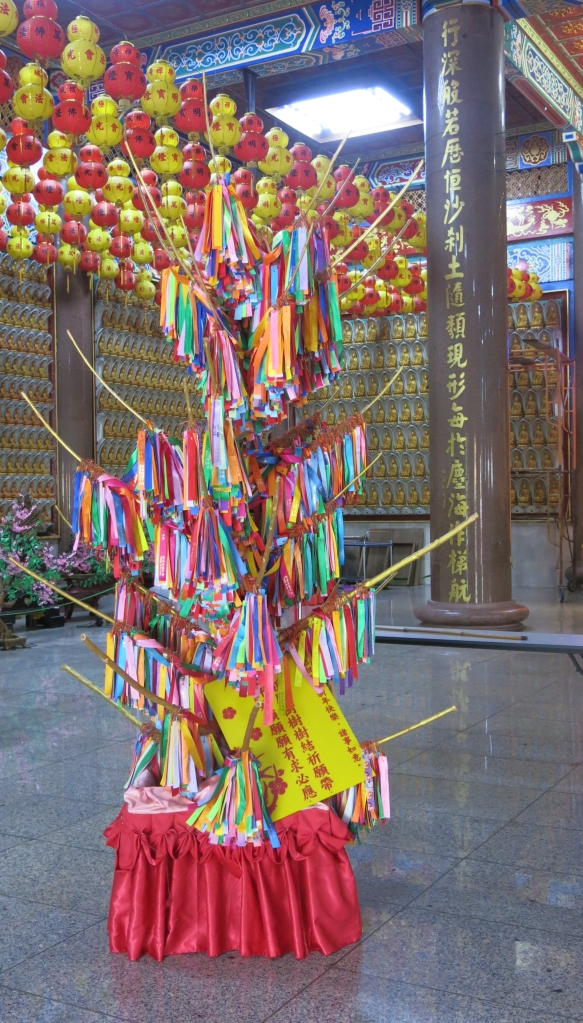
The Wishing Tree
Incense wafted through the cavernous hall, where various folding tables displayed offerings for purchase to lay before the Buddha of choice. A “Wishing Tree” stood in one area, festooned with colorful ribbons upon which various blessings and wishful outcomes were written.
Elsewhere within the temple complex stands the seven-story Pagoda of the 10,000 Buddhas, along with additional prayer halls and plenty of stone and painted statuary nestled into the hillside. In addition to its height, the pagoda is unique in that it combines three different cultures’ temple architecture: Chinese, Thai and Burmese.
Another interesting feature is the 30 meter (99 feet) statue of Kuan Yin, an East Asian Buddhist deity of mercy and compassion. Most often Kuan Yin, also known as “Guanyin,” is depicted as a woman, although this statue seems more androgynous.
Reclining Buddha Temple
Wat Chayamangkalaram, better known as the “Reclining Buddha Temple” or “Thai Buddhist Temple,” holds the 3rd or 4th largest statue of the Buddha in a reclining pose, depending on your source. At 33 meters (108 ft.), the statue is quite imposing, especially as the Buddha’s robe is gold-plated.
A common misconception among Westerners is that the reclining figure of the Buddha shows him at rest or asleep. The reclining pose actually depicts the Buddha in his last illness, near his death.
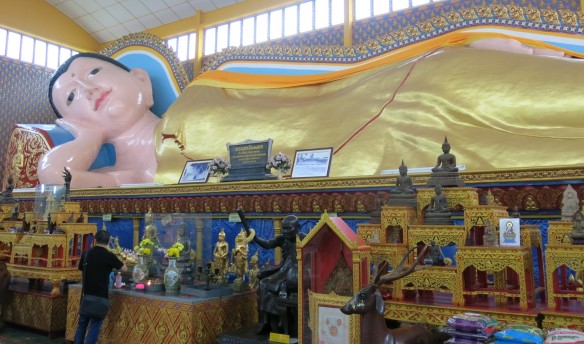
Reclining Buddha at Wat Chayamangkalaram. At 33 m in length, this is one of the largest Reclining Buddhas in the world.
The Standing Buddha Temple

Directly across the street from the Reclining Buddha is Wat Dhammikarama, or the “Burmese Buddhist Temple.” Heavily ornate in its exterior, the simpler interior hall is dominated by the serenely calm “Standing Buddha.” Built in 1803, Dhammikarama was the first Buddhist temple in Penang and reflects the Burmese influence on the island at the time. Dhammikarama is also the only Burmese Buddhist temple outside of Myanmar (Burma).

Lion outside Standing Buddha;note detailed filigree on portico & roof
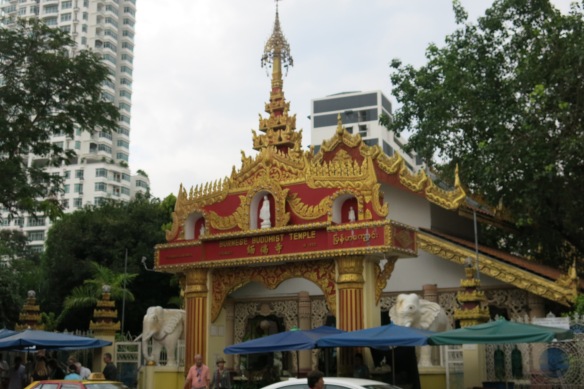
Gate to Burmese Temple
Selamat Tinggal, Penang*
The city of George Town and Penang Island have many more Buddhist and Hindu temples, mosques, and other natural and man-made wonders. Unfortunately, our port of call was only a half day, and these three temples were the only ones we managed to get to. On the more secular end of sights, we drove across both of the two bridges connecting Palau Penang (Penang Island) to the Malaysian mainland. (The newest, just opened in 2014, is the longest bridge in Asia at 27 kilometers.)
We also took the incredibly steep funicular up to the top of Bukit Bandera (Penang Hill). Regrettably, afternoon rain clouds had rolled in so the spectacular view from 800 m. (2,730 ft.) was obscured by the mists. The gardens on the Hill are beautiful, though, and splashes of color made up for the lack of a view.

![]()

Carol Barbier Rolnick grew up in Japan and Southeast Asia, traveling extensively as a child through Asia, the Mideast and Europe on family vacations. Travel has continued as a priority through raising kids and continuing into retirement, extending adventures through the Americas, southern Africa, Asia, and repeat trips throughout Europe. Carol and her husband, Michael spent four summers based in Utrecht, The Netherlands, which has become like a second home. They are (still) aiming towards Australia-New Zealand and Antarctica to round off their continental travels.








